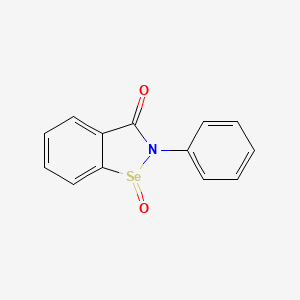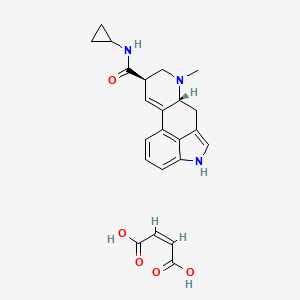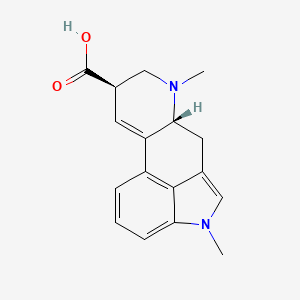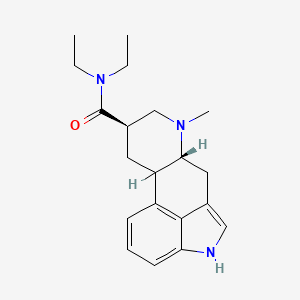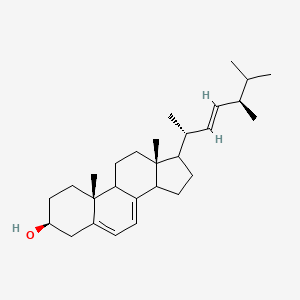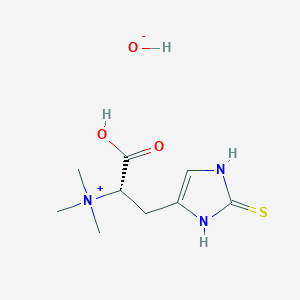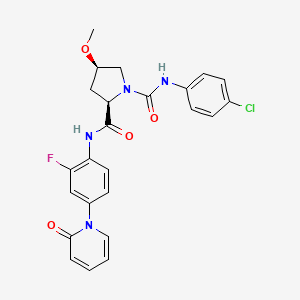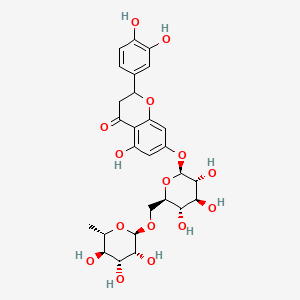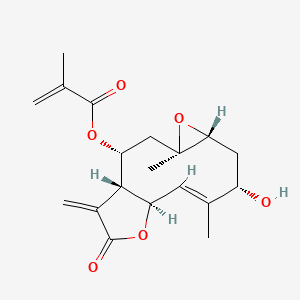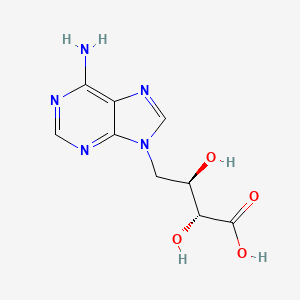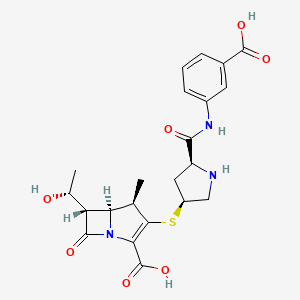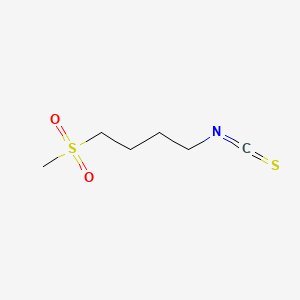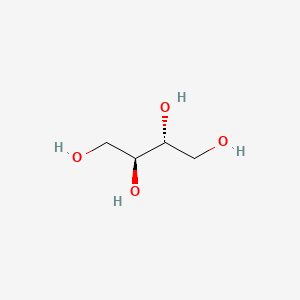
エファビレンツ
概要
説明
エファビレンツは、主にヒト免疫不全ウイルス(HIV)1型感染の治療と予防に使用される非ヌクレオシド系逆転写酵素阻害剤です . これは、SustivaやStocrinなどのブランド名で販売されています . エファビレンツは、HIVの複製に不可欠な酵素である逆転写酵素の活性を阻害することで作用します .
2. 製法
合成経路と反応条件: エファビレンツの主要な合成経路の1つは、n-ブチルリチウムを用いたN-Boc-4-クロロアニリンのオルトリチオ化反応です . この反応は-45℃で実施され、重要な中間体を生成し、その後トリフルオロアセチル化されます . 別の方法では、ヘプタン、トルエン、テトラヒドロフランなどの溶媒中でエファビレンツ中間体とホスゲンを反応させます .
工業生産方法: エファビレンツの工業生産では、多くの場合、反応の選択性と安全性を向上させるために連続フロー化学が用いられます . この方法により、プロセスの効率的なスケールアップが可能になり、大規模生産に適しています。
作用機序
エファビレンツは、HIV-1の逆転写酵素に結合することで効果を発揮します . この結合は、酵素の活性を阻害し、ウイルスRNAをDNAに変換することを防ぎます。これは、ウイルスの複製サイクルにおける重要なステップです . ヌクレオシド系逆転写酵素阻害剤とは異なり、エファビレンツは、その活性を発揮するために細胞内リン酸化を必要としません .
類似化合物:
ネビラピン: HIV治療に使用される別の非ヌクレオシド系逆転写酵素阻害剤です。
デラビルジン: エファビレンツと同様に逆転写酵素を阻害しますが、薬物動態が異なります。
エトラビリン: より新しい非ヌクレオシド系逆転写酵素阻害剤で、より幅広い耐性プロファイルを持っています。
エファビレンツの独自性: エファビレンツは、その高い効力と長い半減期により、1日1回の投与が可能です . 15年以上、主要な第一選択の抗ウイルス薬であり、併用療法における有効性で知られています . 中枢神経系の症状などの副作用により、使用が制限される場合があります .
科学的研究の応用
Efavirenz has a wide range of scientific research applications:
Chemistry: It is used as a model compound in studies involving non-nucleoside reverse transcriptase inhibitors.
Biology: Efavirenz is studied for its effects on cellular processes and its interactions with various biological molecules.
Medicine: It is a key component of highly active antiretroviral therapy (HAART) for HIV treatment.
Industry: Efavirenz is used in the pharmaceutical industry for the development of antiretroviral drugs and formulations.
生化学分析
Biochemical Properties
Efavirenz interacts with several enzymes and proteins. It is primarily metabolized by cytochrome P450 enzymes, including CYP2B6, CYP2A6, and CYP3A4 . Efavirenz acts as a non-competitive inhibitor of HIV-1 reverse transcriptase . It binds to this enzyme, blocking its function and preventing the replication of HIV .
Cellular Effects
Efavirenz has various effects on cells. It has been associated with neurological and neuropsychiatric reactions ranging from transitory effects such as nightmares, dizziness, insomnia, nervousness, and lack of concentration, to more severe symptoms including depression, suicidal ideation, or even psychosis . Efavirenz has also been linked to mild/moderate neurocognitive impairment .
Molecular Mechanism
Efavirenz exerts its effects at the molecular level by blocking the function of reverse transcriptase, an enzyme crucial for the replication of HIV . It binds non-competitively to the hydrophobic region of the HIV-1 reverse transcriptase through an allosteric mechanism that alters the enzyme conformation and prevents access to the substrates .
Temporal Effects in Laboratory Settings
The majority of efavirenz-induced CNS effects appear early, even after a single dose, and mitigate within 1 month . In a substantial number of cases, effects such as abnormal dreams, anxiety, or depression persist for much longer periods and require a change of treatment .
Dosage Effects in Animal Models
In animal models, perinatal efavirenz exposure resulted in reduced body weight and delayed reflex and motor development . During adulthood, a decrease in the total number of cells and mature neurons in the motor cortex was observed, as well as an increase in the number of Caspase-3-positive cells and serotonergic fibers .
Metabolic Pathways
Efavirenz is involved in several metabolic pathways. It is primarily metabolized by CYP2B6 into 8-hydroxyefavirenz and to a lesser extent via pathways involving CYP2A6, CYP3A4/5, and UGT2B7 .
準備方法
Synthetic Routes and Reaction Conditions: One of the key synthetic routes for efavirenz involves the ortho-lithiation reaction of N-Boc-4-chloroaniline using n-butyllithium . This reaction is performed at a temperature of -45°C and yields a key intermediate, which is then subjected to trifluoroacetylation . Another method involves the reaction of an efavirenz intermediate with phosgene in solvents such as heptane, toluene, or tetrahydrofuran .
Industrial Production Methods: Industrial production of efavirenz often employs continuous flow chemistry to improve the selectivity and safety of the reactions . This method allows for the efficient scale-up of the process, making it suitable for large-scale production.
化学反応の分析
反応の種類: エファビレンツは、次のようなさまざまな化学反応を起こします。
酸化: エファビレンツは、特定の条件下で酸化されて異なる代謝物を生成することができます。
還元: 還元反応は、エファビレンツに存在する官能基を変換することができます。
置換: 分子中のクロロ基またはトリフルオロメチル基で置換反応が起こる可能性があります。
一般的な試薬と条件:
酸化: 一般的な酸化剤には、過酸化水素や過マンガン酸カリウムなどがあります。
還元: 水素化アルミニウムリチウムなどの還元剤を使用できます。
置換: 水酸化ナトリウムやその他の強塩基などの試薬は、置換反応を促進することができます。
生成される主な生成物: これらの反応から生成される主な生成物は、使用される特定の条件と試薬によって異なります。たとえば、酸化により水酸化代謝物が生成され、還元により脱塩素化または脱フッ素化された生成物が生成される可能性があります。
4. 科学研究における用途
エファビレンツは、幅広い科学研究における用途があります。
化学: 非ヌクレオシド系逆転写酵素阻害剤に関する研究でモデル化合物として使用されます。
生物学: エファビレンツは、細胞プロセスへの影響とそのさまざまな生体分子との相互作用について研究されています。
医学: HIV治療のための高活性抗レトロウイルス療法(HAART)の主要な成分です.
産業: エファビレンツは、製薬業界で抗レトロウイルス薬や製剤の開発に使用されています。
類似化合物との比較
Nevirapine: Another non-nucleoside reverse transcriptase inhibitor used in HIV treatment.
Delavirdine: Similar to efavirenz, it inhibits reverse transcriptase but has different pharmacokinetic properties.
Etravirine: A newer non-nucleoside reverse transcriptase inhibitor with a broader resistance profile.
Uniqueness of Efavirenz: Efavirenz is unique due to its high potency and long half-life, which allows for once-daily dosing . It has been a primary first-line antiviral drug for over 15 years and is known for its effectiveness in combination therapy . its use is sometimes limited by side effects such as central nervous system symptoms .
特性
IUPAC Name |
(4S)-6-chloro-4-(2-cyclopropylethynyl)-4-(trifluoromethyl)-1H-3,1-benzoxazin-2-one | |
|---|---|---|
| Source | PubChem | |
| URL | https://pubchem.ncbi.nlm.nih.gov | |
| Description | Data deposited in or computed by PubChem | |
InChI |
InChI=1S/C14H9ClF3NO2/c15-9-3-4-11-10(7-9)13(14(16,17)18,21-12(20)19-11)6-5-8-1-2-8/h3-4,7-8H,1-2H2,(H,19,20)/t13-/m0/s1 | |
| Source | PubChem | |
| URL | https://pubchem.ncbi.nlm.nih.gov | |
| Description | Data deposited in or computed by PubChem | |
InChI Key |
XPOQHMRABVBWPR-ZDUSSCGKSA-N | |
| Source | PubChem | |
| URL | https://pubchem.ncbi.nlm.nih.gov | |
| Description | Data deposited in or computed by PubChem | |
Canonical SMILES |
C1CC1C#CC2(C3=C(C=CC(=C3)Cl)NC(=O)O2)C(F)(F)F | |
| Source | PubChem | |
| URL | https://pubchem.ncbi.nlm.nih.gov | |
| Description | Data deposited in or computed by PubChem | |
Isomeric SMILES |
C1CC1C#C[C@]2(C3=C(C=CC(=C3)Cl)NC(=O)O2)C(F)(F)F | |
| Source | PubChem | |
| URL | https://pubchem.ncbi.nlm.nih.gov | |
| Description | Data deposited in or computed by PubChem | |
Molecular Formula |
C14H9ClF3NO2 | |
| Source | PubChem | |
| URL | https://pubchem.ncbi.nlm.nih.gov | |
| Description | Data deposited in or computed by PubChem | |
DSSTOX Substance ID |
DTXSID9046029 | |
| Record name | Efavirenz | |
| Source | EPA DSSTox | |
| URL | https://comptox.epa.gov/dashboard/DTXSID9046029 | |
| Description | DSSTox provides a high quality public chemistry resource for supporting improved predictive toxicology. | |
Molecular Weight |
315.67 g/mol | |
| Source | PubChem | |
| URL | https://pubchem.ncbi.nlm.nih.gov | |
| Description | Data deposited in or computed by PubChem | |
Physical Description |
Solid | |
| Record name | Efavirenz | |
| Source | Human Metabolome Database (HMDB) | |
| URL | http://www.hmdb.ca/metabolites/HMDB0014763 | |
| Description | The Human Metabolome Database (HMDB) is a freely available electronic database containing detailed information about small molecule metabolites found in the human body. | |
| Explanation | HMDB is offered to the public as a freely available resource. Use and re-distribution of the data, in whole or in part, for commercial purposes requires explicit permission of the authors and explicit acknowledgment of the source material (HMDB) and the original publication (see the HMDB citing page). We ask that users who download significant portions of the database cite the HMDB paper in any resulting publications. | |
Solubility |
Practically insoluble in water (less than 10 mg/L), 8.55e-03 g/L | |
| Record name | EFAVIRENZ | |
| Source | Hazardous Substances Data Bank (HSDB) | |
| URL | https://pubchem.ncbi.nlm.nih.gov/source/hsdb/7163 | |
| Description | The Hazardous Substances Data Bank (HSDB) is a toxicology database that focuses on the toxicology of potentially hazardous chemicals. It provides information on human exposure, industrial hygiene, emergency handling procedures, environmental fate, regulatory requirements, nanomaterials, and related areas. The information in HSDB has been assessed by a Scientific Review Panel. | |
| Record name | Efavirenz | |
| Source | Human Metabolome Database (HMDB) | |
| URL | http://www.hmdb.ca/metabolites/HMDB0014763 | |
| Description | The Human Metabolome Database (HMDB) is a freely available electronic database containing detailed information about small molecule metabolites found in the human body. | |
| Explanation | HMDB is offered to the public as a freely available resource. Use and re-distribution of the data, in whole or in part, for commercial purposes requires explicit permission of the authors and explicit acknowledgment of the source material (HMDB) and the original publication (see the HMDB citing page). We ask that users who download significant portions of the database cite the HMDB paper in any resulting publications. | |
Mechanism of Action |
Similar to zidovudine, efavirenz inhibits the activity of viral RNA-directed DNA polymerase (i.e., reverse transcriptase). Antiviral activity of efavirenz is dependent on intracellular conversion to the active triphosphorylated form. The rate of efavirenz phosphorylation varies, depending on cell type. It is believed that inhibition of reverse transcriptase interferes with the generation of DNA copies of viral RNA, which, in turn, are necessary for synthesis of new virions. Intracellular enzymes subsequently eliminate the HIV particle that previously had been uncoated, and left unprotected, during entry into the host cell. Thus, reverse transcriptase inhibitors are virustatic and do not eliminate HIV from the body. Even though human DNA polymerase is less susceptible to the pharmacologic effects of triphosphorylated efavirenz, this action may nevertheless account for some of the drug's toxicity., Efavirenz diffuses into the cell where it binds adjacent to the active site of reverse transcriptase. This produces a conformational change in the enzyme that inhibits function. | |
| Record name | Efavirenz | |
| Source | DrugBank | |
| URL | https://www.drugbank.ca/drugs/DB00625 | |
| Description | The DrugBank database is a unique bioinformatics and cheminformatics resource that combines detailed drug (i.e. chemical, pharmacological and pharmaceutical) data with comprehensive drug target (i.e. sequence, structure, and pathway) information. | |
| Explanation | Creative Common's Attribution-NonCommercial 4.0 International License (http://creativecommons.org/licenses/by-nc/4.0/legalcode) | |
| Record name | EFAVIRENZ | |
| Source | Hazardous Substances Data Bank (HSDB) | |
| URL | https://pubchem.ncbi.nlm.nih.gov/source/hsdb/7163 | |
| Description | The Hazardous Substances Data Bank (HSDB) is a toxicology database that focuses on the toxicology of potentially hazardous chemicals. It provides information on human exposure, industrial hygiene, emergency handling procedures, environmental fate, regulatory requirements, nanomaterials, and related areas. The information in HSDB has been assessed by a Scientific Review Panel. | |
Color/Form |
Crystals from toluene:heptane, White to slightly pink crystalline powder | |
CAS No. |
154598-52-4 | |
| Record name | Efavirenz | |
| Source | CAS Common Chemistry | |
| URL | https://commonchemistry.cas.org/detail?cas_rn=154598-52-4 | |
| Description | CAS Common Chemistry is an open community resource for accessing chemical information. Nearly 500,000 chemical substances from CAS REGISTRY cover areas of community interest, including common and frequently regulated chemicals, and those relevant to high school and undergraduate chemistry classes. This chemical information, curated by our expert scientists, is provided in alignment with our mission as a division of the American Chemical Society. | |
| Explanation | The data from CAS Common Chemistry is provided under a CC-BY-NC 4.0 license, unless otherwise stated. | |
| Record name | Efavirenz [USP:INN:BAN] | |
| Source | ChemIDplus | |
| URL | https://pubchem.ncbi.nlm.nih.gov/substance/?source=chemidplus&sourceid=0154598524 | |
| Description | ChemIDplus is a free, web search system that provides access to the structure and nomenclature authority files used for the identification of chemical substances cited in National Library of Medicine (NLM) databases, including the TOXNET system. | |
| Record name | Efavirenz | |
| Source | DrugBank | |
| URL | https://www.drugbank.ca/drugs/DB00625 | |
| Description | The DrugBank database is a unique bioinformatics and cheminformatics resource that combines detailed drug (i.e. chemical, pharmacological and pharmaceutical) data with comprehensive drug target (i.e. sequence, structure, and pathway) information. | |
| Explanation | Creative Common's Attribution-NonCommercial 4.0 International License (http://creativecommons.org/licenses/by-nc/4.0/legalcode) | |
| Record name | 154598-52-4 | |
| Source | DTP/NCI | |
| URL | https://dtp.cancer.gov/dtpstandard/servlet/dwindex?searchtype=NSC&outputformat=html&searchlist=742403 | |
| Description | The NCI Development Therapeutics Program (DTP) provides services and resources to the academic and private-sector research communities worldwide to facilitate the discovery and development of new cancer therapeutic agents. | |
| Explanation | Unless otherwise indicated, all text within NCI products is free of copyright and may be reused without our permission. Credit the National Cancer Institute as the source. | |
| Record name | Efavirenz | |
| Source | EPA DSSTox | |
| URL | https://comptox.epa.gov/dashboard/DTXSID9046029 | |
| Description | DSSTox provides a high quality public chemistry resource for supporting improved predictive toxicology. | |
| Record name | (4S)-6-chloro-4-(2-cyclopropylethynyl)-4-(trifluoromethyl)-2,4-dihydro-1H-3,1-benzoxazin-2-one | |
| Source | European Chemicals Agency (ECHA) | |
| URL | https://echa.europa.eu/information-on-chemicals | |
| Description | The European Chemicals Agency (ECHA) is an agency of the European Union which is the driving force among regulatory authorities in implementing the EU's groundbreaking chemicals legislation for the benefit of human health and the environment as well as for innovation and competitiveness. | |
| Explanation | Use of the information, documents and data from the ECHA website is subject to the terms and conditions of this Legal Notice, and subject to other binding limitations provided for under applicable law, the information, documents and data made available on the ECHA website may be reproduced, distributed and/or used, totally or in part, for non-commercial purposes provided that ECHA is acknowledged as the source: "Source: European Chemicals Agency, http://echa.europa.eu/". Such acknowledgement must be included in each copy of the material. ECHA permits and encourages organisations and individuals to create links to the ECHA website under the following cumulative conditions: Links can only be made to webpages that provide a link to the Legal Notice page. | |
| Record name | EFAVIRENZ | |
| Source | FDA Global Substance Registration System (GSRS) | |
| URL | https://gsrs.ncats.nih.gov/ginas/app/beta/substances/JE6H2O27P8 | |
| Description | The FDA Global Substance Registration System (GSRS) enables the efficient and accurate exchange of information on what substances are in regulated products. Instead of relying on names, which vary across regulatory domains, countries, and regions, the GSRS knowledge base makes it possible for substances to be defined by standardized, scientific descriptions. | |
| Explanation | Unless otherwise noted, the contents of the FDA website (www.fda.gov), both text and graphics, are not copyrighted. They are in the public domain and may be republished, reprinted and otherwise used freely by anyone without the need to obtain permission from FDA. Credit to the U.S. Food and Drug Administration as the source is appreciated but not required. | |
| Record name | EFAVIRENZ | |
| Source | Hazardous Substances Data Bank (HSDB) | |
| URL | https://pubchem.ncbi.nlm.nih.gov/source/hsdb/7163 | |
| Description | The Hazardous Substances Data Bank (HSDB) is a toxicology database that focuses on the toxicology of potentially hazardous chemicals. It provides information on human exposure, industrial hygiene, emergency handling procedures, environmental fate, regulatory requirements, nanomaterials, and related areas. The information in HSDB has been assessed by a Scientific Review Panel. | |
| Record name | Efavirenz | |
| Source | Human Metabolome Database (HMDB) | |
| URL | http://www.hmdb.ca/metabolites/HMDB0014763 | |
| Description | The Human Metabolome Database (HMDB) is a freely available electronic database containing detailed information about small molecule metabolites found in the human body. | |
| Explanation | HMDB is offered to the public as a freely available resource. Use and re-distribution of the data, in whole or in part, for commercial purposes requires explicit permission of the authors and explicit acknowledgment of the source material (HMDB) and the original publication (see the HMDB citing page). We ask that users who download significant portions of the database cite the HMDB paper in any resulting publications. | |
Melting Point |
139-141 °C, 139 - 141 °C | |
| Record name | Efavirenz | |
| Source | DrugBank | |
| URL | https://www.drugbank.ca/drugs/DB00625 | |
| Description | The DrugBank database is a unique bioinformatics and cheminformatics resource that combines detailed drug (i.e. chemical, pharmacological and pharmaceutical) data with comprehensive drug target (i.e. sequence, structure, and pathway) information. | |
| Explanation | Creative Common's Attribution-NonCommercial 4.0 International License (http://creativecommons.org/licenses/by-nc/4.0/legalcode) | |
| Record name | EFAVIRENZ | |
| Source | Hazardous Substances Data Bank (HSDB) | |
| URL | https://pubchem.ncbi.nlm.nih.gov/source/hsdb/7163 | |
| Description | The Hazardous Substances Data Bank (HSDB) is a toxicology database that focuses on the toxicology of potentially hazardous chemicals. It provides information on human exposure, industrial hygiene, emergency handling procedures, environmental fate, regulatory requirements, nanomaterials, and related areas. The information in HSDB has been assessed by a Scientific Review Panel. | |
| Record name | Efavirenz | |
| Source | Human Metabolome Database (HMDB) | |
| URL | http://www.hmdb.ca/metabolites/HMDB0014763 | |
| Description | The Human Metabolome Database (HMDB) is a freely available electronic database containing detailed information about small molecule metabolites found in the human body. | |
| Explanation | HMDB is offered to the public as a freely available resource. Use and re-distribution of the data, in whole or in part, for commercial purposes requires explicit permission of the authors and explicit acknowledgment of the source material (HMDB) and the original publication (see the HMDB citing page). We ask that users who download significant portions of the database cite the HMDB paper in any resulting publications. | |
Retrosynthesis Analysis
AI-Powered Synthesis Planning: Our tool employs the Template_relevance Pistachio, Template_relevance Bkms_metabolic, Template_relevance Pistachio_ringbreaker, Template_relevance Reaxys, Template_relevance Reaxys_biocatalysis model, leveraging a vast database of chemical reactions to predict feasible synthetic routes.
One-Step Synthesis Focus: Specifically designed for one-step synthesis, it provides concise and direct routes for your target compounds, streamlining the synthesis process.
Accurate Predictions: Utilizing the extensive PISTACHIO, BKMS_METABOLIC, PISTACHIO_RINGBREAKER, REAXYS, REAXYS_BIOCATALYSIS database, our tool offers high-accuracy predictions, reflecting the latest in chemical research and data.
Strategy Settings
| Precursor scoring | Relevance Heuristic |
|---|---|
| Min. plausibility | 0.01 |
| Model | Template_relevance |
| Template Set | Pistachio/Bkms_metabolic/Pistachio_ringbreaker/Reaxys/Reaxys_biocatalysis |
| Top-N result to add to graph | 6 |
Feasible Synthetic Routes
A: Efavirenz is a non-nucleoside reverse transcriptase inhibitor (NNRTI) that binds non-competitively to the reverse transcriptase enzyme of HIV-1. [, , , ] This binding occurs in a hydrophobic pocket within the p66 subunit of the enzyme, distinct from the binding site of nucleoside/nucleotide reverse transcriptase inhibitors (NRTIs). [] Efavirenz's binding alters the conformation of critical amino acids in the enzyme's catalytic site, inhibiting the conversion of viral RNA into DNA and, therefore, viral replication. []
A: By inhibiting reverse transcriptase, efavirenz prevents the formation of proviral DNA, effectively halting the replication cycle of HIV-1. [] This inhibition leads to a decrease in viral load and an increase in CD4+ T-cell count in infected individuals. [, , , ]
ANone: Efavirenz has the molecular formula C14H9ClF3NO2 and a molecular weight of 315.68 g/mol.
A: Yes, physiologically based pharmacokinetic (PBPK) simulations have been employed to model efavirenz distribution in various body compartments, including plasma, cerebrospinal fluid, and brain tissue. [] These models can be valuable tools for predicting drug exposure and potentially optimizing dosing regimens.
A: While the provided abstracts don't delve into specific SAR studies, they highlight that modifications to the efavirenz molecule can impact its pharmacological properties. For instance, efavirenz is metabolized by CYP2B6 and CYP3A4 enzymes. [, ] Genetic polymorphisms in these enzymes, particularly CYP2B6, significantly influence efavirenz plasma concentrations, potentially impacting efficacy and toxicity. [, , , , , ] This emphasizes the importance of SAR studies in understanding and optimizing the therapeutic profile of efavirenz.
A: One abstract explores the development of a solid drug nanoformulation (SDN) of efavirenz. [] This nanoformulation aimed to mitigate efavirenz-associated limitations, potentially improving its bioavailability and reducing toxicity.
A: Efavirenz is administered orally and is well-absorbed. [, , , ] It undergoes extensive metabolism primarily by CYP3A4 and CYP2B6 enzymes in the liver, with 8-hydroxyefavirenz as the major metabolite. [, , , , ]
ANone: Numerous factors can impact efavirenz pharmacokinetics, including:
- Genetic factors: Polymorphisms in CYP2B6 are particularly influential on efavirenz plasma levels. [, , , , , , ] Individuals with certain CYP2B6 genotypes may exhibit significantly higher or lower efavirenz exposure.
- Concomitant medications: Drugs that induce or inhibit CYP3A4 and CYP2B6 can alter efavirenz metabolism, leading to interactions. [, , , , , , ]
- Ethnicity: Studies show variations in efavirenz pharmacokinetics across different ethnic groups. [, , ] For example, some studies observed higher efavirenz plasma concentrations in Black African patients compared with other populations.
- Body weight: Obesity, particularly abdominal obesity, has been associated with lower efavirenz plasma concentrations. []
- Liver function: Liver cirrhosis may lead to elevated efavirenz plasma levels due to impaired metabolism. [, ]
A: Yes, in vitro models, including primary rat neurons and Hep3B cells (a human liver cell line), have been used to investigate the potential toxicity of efavirenz and compare its profile to newer antiretrovirals. []
A: The most frequent HIV-1 mutation associated with efavirenz treatment failure is the K103N substitution in the reverse transcriptase gene. [, ] This mutation, often emerging alongside other NNRTI resistance mutations, confers cross-resistance to nevirapine, another NNRTI. [, , ]
A: Studies suggest that the use of thymidine analogue NRTIs (like zidovudine or stavudine) alongside nevirapine might be linked to a higher selection of mutations conferring cross-resistance to efavirenz. []
A: The most prominent concern with efavirenz is its potential for neuropsychiatric adverse events, including: [, , , ] * Abnormal dreams * Sleep disturbances * Nervousness * Anxiety * Depression * Dizziness
A: Research suggests that:* Efavirenz plasma concentrations: Monitoring efavirenz plasma levels can be valuable for guiding dose adjustments, particularly in individuals at risk of toxicity or subtherapeutic exposure. [, , , ] * Genetic polymorphisms: CYP2B6 genotypes are considered strong predictors of efavirenz plasma concentrations and may be used to personalize therapy. [, , , , ]* Baseline liver function tests: Pre-existing liver disease, particularly cirrhosis, is associated with altered efavirenz pharmacokinetics and may require closer monitoring for potential toxicity. []
ANone: Several analytical methods are utilized in efavirenz studies:
- High-performance liquid chromatography (HPLC): This technique is widely used to measure efavirenz concentrations in biological matrices, such as plasma. [, , , , , ]
- Liquid chromatography-mass spectrometry (LC-MS): This highly sensitive and specific method allows for the simultaneous quantification of efavirenz and other antiretroviral drugs in complex biological samples. [, , ]
- Allele-specific PCR (AS-PCR): This molecular technique is used to detect specific HIV-1 mutations, such as the K103N mutation associated with efavirenz resistance. []
A: While not directly addressed in the provided research, one abstract suggests that efavirenz does not meet the criteria for a rapidly dissolving product according to the Biopharmaceutics Classification System. [] Factors such as excipients and manufacturing processes can affect efavirenz absorption, underscoring the importance of dissolution studies for ensuring consistent bioavailability.
A: Evidence suggests that efavirenz might interact with drug transporters. One study observed a significant reduction in cellular efavirenz accumulation in the presence of transporter inhibitors like montelukast (an inhibitor of organic anion transporting polypeptide 1B1) and amantadine (an inhibitor of organic cation transporter 1). [] This suggests that efavirenz could be a substrate for these transporters.
ANone: Efavirenz exhibits a complex interplay of inhibitory and inducing effects on drug-metabolizing enzymes:
- Inhibition: In vitro studies demonstrate that efavirenz inhibits various CYP450 enzymes, including CYP2C9, CYP2C19, CYP3A4, CYP2D6, and CYP1A2. []
A: Yes, several alternative NNRTIs exist, including: * Nevirapine: While also effective, nevirapine has its own set of potential side effects and drug interactions. [, , , , ] * Rilpivirine: This newer NNRTI shows a potentially safer toxicological profile than efavirenz. [] * Etravirine: In clinical trials, etravirine demonstrated comparable efficacy to efavirenz with a potentially more favorable neuropsychiatric profile. []
ANone: Yes, several research areas highlight the cross-disciplinary nature of efavirenz research:
- Pharmacogenetics: This field combines pharmacology and genetics to understand the impact of genetic variations on drug response, as seen with the significant influence of CYP2B6 polymorphisms on efavirenz pharmacokinetics. [, , , , , ]
- Drug formulation: Nanoformulations of efavirenz, as mentioned in one abstract, demonstrate the intersection of pharmaceutical sciences and nanotechnology to improve drug delivery and therapeutic outcomes. []
- Cellular and molecular biology: In vitro studies using cell lines and primary cells are essential for investigating the mechanisms of efavirenz action and toxicity, bridging pharmacology with cellular and molecular biology. []
試験管内研究製品の免責事項と情報
BenchChemで提示されるすべての記事および製品情報は、情報提供を目的としています。BenchChemで購入可能な製品は、生体外研究のために特別に設計されています。生体外研究は、ラテン語の "in glass" に由来し、生物体の外で行われる実験を指します。これらの製品は医薬品または薬として分類されておらず、FDAから任何の医療状態、病気、または疾患の予防、治療、または治癒のために承認されていません。これらの製品を人間または動物に体内に導入する形態は、法律により厳格に禁止されています。これらのガイドラインに従うことは、研究と実験において法的および倫理的な基準の遵守を確実にするために重要です。


![1-(Carbamoylamino)-1-oxopropan-2-yl 3-[(3,4-dimethoxyphenyl)methylidene]-1H,2H,3H-cyclopenta[b]quinoline-9-carboxylate](/img/structure/B1671038.png)
